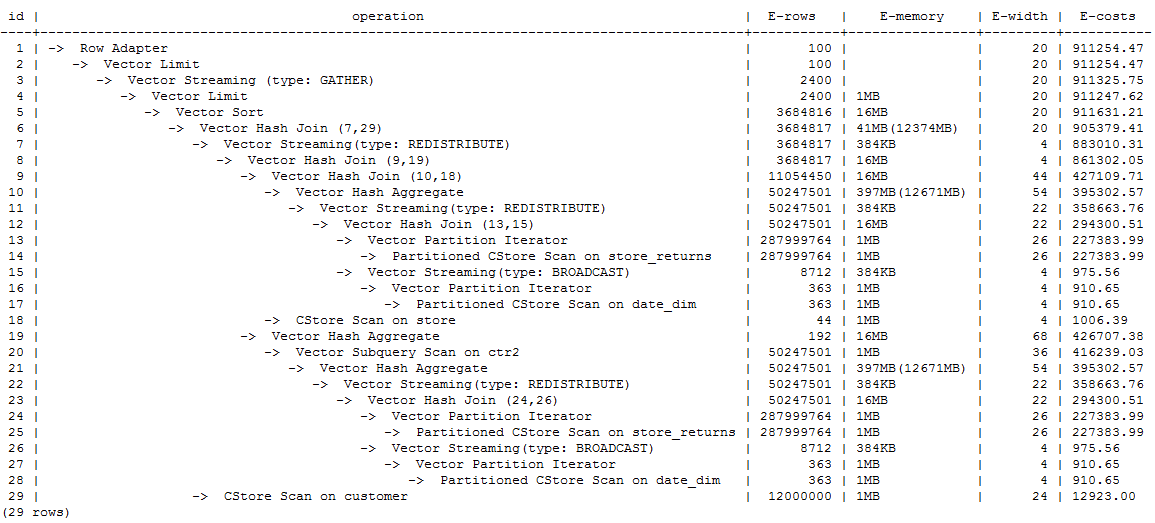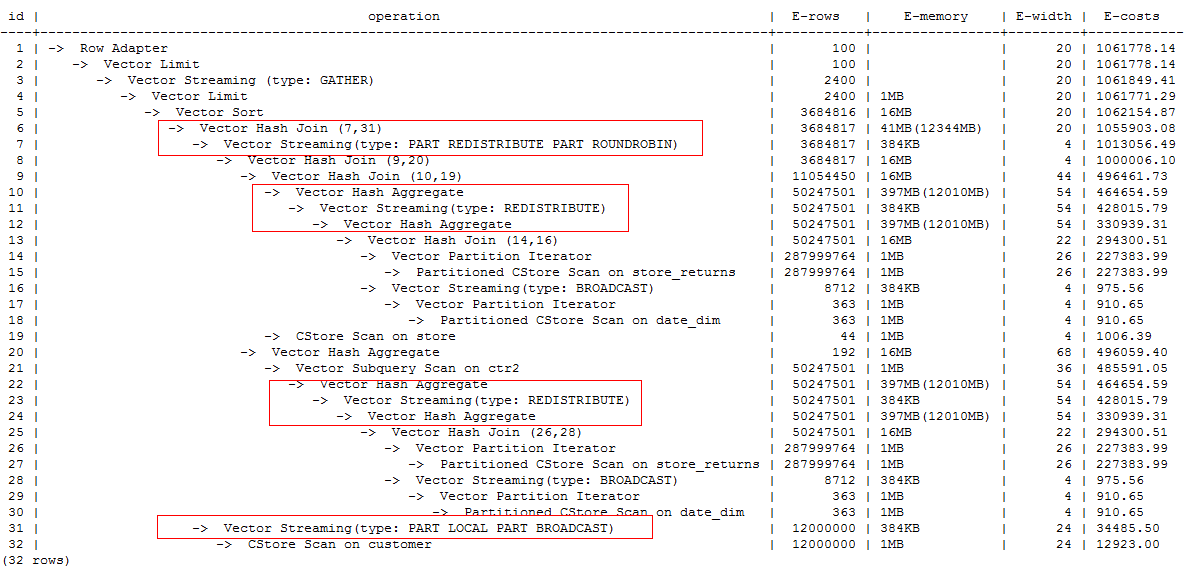Skew Hints
Function
Theses hints specify redistribution keys containing skew data and skew values, and are used to optimize redistribution involving Join or HashAgg.
Precautions
- Skew hints are used only if redistribution is required and the specified skew information matches the redistribution information.
- Skew hints are controlled by the GUC parameter skew_option. If the parameter is disabled, skew hints cannot be used for solving skew.
- Currently, skew hints support only the table relationships of the ordinary table and subquery types. Hints can be specified for base tables, subqueries, and WITH ... AS clauses. Unlike other hints, a subquery can be used in skew hints regardless of whether it is pulled up.
- Use an alias (if any) to specify a table where data skew occurs.
- You can use a name or an alias to specify a skew column as long as it is not ambiguous. The columns in skew hints cannot be expressions. If data skew occurs in the redistribution that uses an expression as a redistribution key, set the redistribution key as a new column and specify the column in skew hints.
- The number of skew values must be an integer multiple of the number of columns. Skew values must be grouped based on the column sequence, with each group containing a maximum of 10 values. You can specify duplicate values to group skew columns having different number of skew values. For example, the c1 and c2 columns of the t1 table contains skew data. The skew value of the c1 column is a1, and the skew values of the c2 column are b1 and b2. In this case, the skew hint is skew(t1 (c1 c2) ((a1 b1)(a1 b2))). (a1 b1) is a value group, where NULL is allowed as a skew value. Each hint can contain a maximum of 10 groups and the number of groups should be an integer multiple of the number of columns.
- In the redistribution optimization of Join, a skew value must be specified for skew hints. The skew value can be left empty for HashAgg.
- If multiple tables, columns, or values are specified, separate items of the same type with spaces.
- The type of skew values cannot be forcibly converted in hints. To specify a string, enclose it with single quotation marks (' ').
Syntax
- Specify single-table skew.
1skew([@block_name] table (column) [(value)])
- Specify intermediate result skew.
1skew([@block_name] (join_rel) (column) [(value)])
Parameter Description
- block_name indicates the block name of the statement block. For details, see block_name.
- table specifies the table where skew occurs.

- The syntax format of the table is as follows:
The table name can contain the schema name or block name before the subquery statement block is promoted. If the subquery statement block is optimized and rewritten by the optimizer, the value of block_name is different from that of block_name in leading.
- If a table has an alias, the alias is preferentially used to represent the table.
- The syntax format of the table is as follows:
- join_rel specifies two or more joined tables. For example, (t1 t2) indicates that the result of joining t1 and t2 tables contains skew data.
- column specifies one or more columns where skew occurs.
- value specifies one or more skew values.
Example:
- Specify single-table skew.
Each skew hint describes the skew information of one table relationship. To describe the skews of multiple table relationships in a query, specify multiple skew hints.
Skew hints have the following formats:
- One skew value in one column: skew(t (c1) (v1))
Description: The v1 value in the c1 column of the t table relationship causes skew in query execution.
- Multiple skew values in one column: skew(t (c1) (v1 v2 v3 ...))
Description: Values including v1, v2, and v3 in the c1 column of the t table relationship cause skew in query execution.
- Multiple columns, each having one skew value: skew(t (c1 c2) (v1 v2))
Description: The v1 value in the c1 column and the v2 value in the c2 column of the t table relationship cause skew in query execution.
- Multiple columns, each having multiple skew values: skew(t (c1 c2) ((v1 v2) (v3 v4) (v5 v6) ...))
Description: Values including v1, v3, and v5 in the c1 column and values including v2, v4, and v6 in the c2 column of the t table relationship cause skew in query execution.

In the last format, parentheses for skew value groups can be omitted, for example, skew(t (c1 c2) (v1 v2 v3 v4 v5 v6 ...)). In a skew hint, either use parentheses for all skew value groups or for none of them.
Otherwise, a syntax error will be generated. For example, skew(t (c1 c2) (v1 v2 v3 v4 (v5 v6) ...)) will generate an error.
- One skew value in one column: skew(t (c1) (v1))
- Specify intermediate result skew.
If data skew does not occur in base tables but in an intermediate result during query execution, specify skew hints of the intermediate result to solve the skew. The format is skew((t1 t2) (c1) (v1)).
Description: Data skew occurs after the table relationships t1 and t2 are joined. The c1 column of the t1 table contains skew data and its skew value is v1.
c1 can exist only in a table relationship of join_rel. If there is another column having the same name, use aliases to avoid ambiguity.
Suggestion
- For a multi-level query, write the hint on the layer where data skew occurs.
- For a listed subquery, you can specify the subquery name in a hint. If you know data skew occurs on which base table, directly specify the table.
- Aliases are preferred when you specify a table or column in a hint.
Examples
Specify single-table skew.
- Specify hints in the original query.
For example, the original query is as follows:
1 2 3 4 5 6 7 8 9 10 11 12 13 14 15 16 17 18 19 20 21 22 23
explain with customer_total_return as (select sr_customer_sk as ctr_customer_sk ,sr_store_sk as ctr_store_sk ,sum(SR_FEE) as ctr_total_return from store_returns ,date_dim where sr_returned_date_sk = d_date_sk and d_year =2000 group by sr_customer_sk ,sr_store_sk) select c_customer_id from customer_total_return ctr1 ,store ,customer where ctr1.ctr_total_return > (select avg(ctr_total_return)*1.2 from customer_total_return ctr2 where ctr1.ctr_store_sk = ctr2.ctr_store_sk) and s_store_sk = ctr1.ctr_store_sk and s_state = 'NM' and ctr1.ctr_customer_sk = c_customer_sk order by c_customer_id limit 100;

Specify the hints of HashAgg in the inner with clause and of the outer Hash Join. The query containing hints is as follows:
1 2 3 4 5 6 7 8 9 10 11 12 13 14 15 16 17 18 19 20 21 22 23
explain with customer_total_return as (select /*+ skew(store_returns(sr_store_sk sr_customer_sk)) */sr_customer_sk as ctr_customer_sk ,sr_store_sk as ctr_store_sk ,sum(SR_FEE) as ctr_total_return from store_returns ,date_dim where sr_returned_date_sk = d_date_sk and d_year =2000 group by sr_customer_sk ,sr_store_sk) select /*+ skew(ctr1(ctr_customer_sk)(11))*/ c_customer_id from customer_total_return ctr1 ,store ,customer where ctr1.ctr_total_return > (select avg(ctr_total_return)*1.2 from customer_total_return ctr2 where ctr1.ctr_store_sk = ctr2.ctr_store_sk) and s_store_sk = ctr1.ctr_store_sk and s_state = 'NM' and ctr1.ctr_customer_sk = c_customer_sk order by c_customer_id limit 100;
The hints indicate that the group by in the inner with clause contains skew data during redistribution by HashAgg, corresponding to the original Hash Agg operators 10 and 21; and that the ctr_customer_sk column in the outer ctr1 table contains skew data during redistribution by Hash Join, corresponding to operator 6 in the original plan. The optimized plan is as follows:

To solve data skew in the redistribution, Hash Agg is changed to double-level Agg operators and the redistribution operators used by Hash Join are changed in the optimized plan.
- Modify the query and then specify hints.
For example, the original query and its plan are as follows:
1explain select count(*) from store_sales_1 group by round(ss_list_price);

Columns in hints do not support expressions. To specify hints, rewrite the query as several subqueries. The rewritten query and its plan are as follows:
1 2 3 4 5
explain select count(*) from (select round(ss_list_price),ss_hdemo_sk from store_sales_1)tmp(a,ss_hdemo_sk) group by a;

Ensure that the service logic is not changed during the rewriting.
Specify hints in the rewritten query as follows:
1 2 3 4 5
explain select /*+ skew(tmp(a)) */ count(*) from (select round(ss_list_price),ss_hdemo_sk from store_sales_1)tmp(a,ss_hdemo_sk) group by a;

The plan shows that after Hash Agg is changed to double-layer Agg operators, redistributed data is greatly reduced and redistribution time shortened.
You can specify hints in columns in a subquery, for example:
1 2 3 4 5
explain select /*+ skew(tmp(b)) */ count(*) from (select round(ss_list_price) b,ss_hdemo_sk from store_sales_1)tmp(a,ss_hdemo_sk) group by a;
Feedback
Was this page helpful?
Provide feedbackThank you very much for your feedback. We will continue working to improve the documentation.See the reply and handling status in My Cloud VOC.
For any further questions, feel free to contact us through the chatbot.
Chatbot





